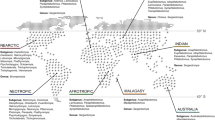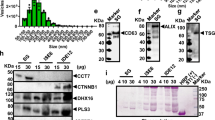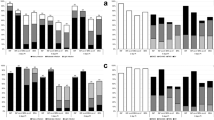Abstract
Sand flies are the exclusive vectors of the protozoan parasite Leishmania1, but the mechanism of transmission by fly bite has not been determined nor incorporated into experimental models of infection. In sand flies with mature Leishmania infections the anterior midgut is blocked by a gel of parasite origin, the promastigote secretory gel2,3. Here we analyse the inocula from Leishmania mexicana-infected Lutzomyia longipalpis sand flies. Analysis revealed the size of the infectious dose, the underlying mechanism of parasite delivery by regurgitation, and the novel contribution made to infection by filamentous proteophosphoglycan (fPPG), a component of promastigote secretory gel found to accompany the parasites during transmission. Collectively these results have important implications for understanding the relationship between the parasite and its vector, the pathology of cutaneous leishmaniasis in humans and also the development of effective vaccines and drugs. These findings emphasize that to fully understand transmission of vector-borne diseases the interaction between the parasite, its vector and the mammalian host must be considered together.
This is a preview of subscription content, access via your institution
Access options
Subscribe to this journal
Receive 51 print issues and online access
$199.00 per year
only $3.90 per issue
Buy this article
- Purchase on Springer Link
- Instant access to full article PDF
Prices may be subject to local taxes which are calculated during checkout




Similar content being viewed by others
References
Sacks, D. L. & Kamhawi, S. Molecular aspects of parasite-vector and vector-host interactions in leishmaniasis. Annu. Rev. Microbiol. 55, 453–483 (2001)
Stierhof, Y.-D. et al. Filamentous proteophosphoglycan secreted by Leishmania promastigotes forms gel-like three-dimensional networks that obstruct the digestive tract of infected sandfly vectors. Eur. J. Cell Biol. 78, 675–689 (1999)
Rogers, M. E., Chance, M. L. & Bates, P. A. The role of promastigote secretory gel in the origin and transmission of the infective stage of Leishmania mexicana by the sandfly Lutzomyia longipalpis. Parasitol. 124, 495–507 (2002)
UNDP/World Bank/WHO. Leishmaniasis 〈http://www.who.int/tdr/diseases/leish/diseaseinfo.htm〉 (2004).
Sacks, D. L. & Perkins, P. V. Identification of an infective stage of Leishmania promastigotes. Science 223, 1417–1419 (1984)
Titus, R. G. & Ribeiro, J. M. Salivary gland lysates from the sand fly Lutzomyia longipalpis enhance Leishmania infectivity. Science 239, 1306–1308 (1988)
Belkaid, Y. et al. Development of a natural model of cutaneous leishmaniasis: powerful effects of vector saliva and saliva preexposure on the long-term outcome of Leishmania major infection in the mouse ear dermis. J. Exp. Med. 188, 1941–1953 (1998)
Schlein, Y., Jacobson, R. L. & Messer, G. Leishmania infections damage the feeding mechanism of the sandfly vector and implement parasite transmission by bite. Proc. Natl Acad. Sci. USA 89, 9944–9948 (1992)
Pimenta, P. F. et al. Stage-specific adhesion of Leishmania promastigotes to the sandfly midgut. Science 256, 1812–1815 (1992)
Sacks, D. L. et al. The role of phosphoglycans in Leishmania-sand fly interactions. Proc. Natl Acad. Sci. USA 97, 406–411 (2000)
Späth, G. F. et al. Lipophosphoglycan is a virulence factor distinct from related glycoconjugates in the protozoan parasite Leishmania major. Proc. Natl Acad. Sci. USA 97, 9258–9263 (2000)
Späth, G. F. et al. Persistence without pathology in phosphoglycan-deficient Leishmania major. Science 301, 1241–1243 (2003)
Ilg, T. et al. Purification and structural characterization of a filamentous, mucin-like proteophosphoglycan secreted by Leishmania parasites. J. Biol. Chem. 271, 21583–21596 (1996)
Ilg, T. Proteophosphoglycans of Leishmania. Trends Parasitol. 16, 489–497 (2000)
Warburg, A. & Schlein, Y. The effect of post-bloodmeal nutrition of Phlebotomus papatasi on the transmission of Leishmania major. Am. J. Trop. Med. Hyg. 35, 926–930 (1986)
Saraiva, E. M. B. et al. Changes in lipophosphoglycan and gene expression associated with the development of Leishmania major in Phlebotomus papatasi. Parasitol. 111, 275–287 (1995)
Kamhawi, S., Belkaid, Y., Modi, G., Rowton, E. & Sacks, D. L. Protection against cutaneous leishmaniasis resulting from bites of uninfected sand flies. Science 290, 1351–1354 (2000)
Castro-Sousa, F. et al. Dissociation between vasodilation and Leishmania-enhancing effects of sand fly saliva and maxadilan. Mem. Inst. Oswaldo Cruz 96, 997–999 (2001)
Wiese, M., Ilg, T., Lottspeich, F. & Overath, P. Ser/Thr-rich repetitive motifs as targets for phosphoglycan modifications in Leishmania mexicana secreted acid phosphatase. EMBO J. 14, 1067–1074 (1995)
Gopfert, U. et al. Proteophosphoglycans of Leishmania mexicana. Molecular characterization of the Leishmania mexicana ppg2 gene encoding the protephosphoglycans aPPG and pPPG2 that are secreted by amastigotes and promastigotes. Biochem. J. 344, 787–795 (1999)
Ilg, T. Lipophosphoglycan is not required for infection of macrophages or mice by Leishmania mexicana. EMBO J. 19, 1953–1962 (2000)
Ilg, T., Demar, M. & Harbecke, D. Phosphoglycan repeat-deficient Leishmania mexicana parasites remain infectious to macrophages and mice. J. Biol. Chem. 276, 4988–4997 (2001)
Nikolaev, A. V., Chudek, J. A. & Ferguson, M. A. J. The chemical synthesis of Leishmania donovani phosphoglycan via polycondensation of a glycobiosyl hydrogen phosphonate monomer. Carbohydr. Res. 272, 179–189 (1995)
Beach, R., Kiilu, G. & Leeuwenburg, J. Modification of sandfly biting behaviour by Leishmania leads to increased parasite transmission. Am. J. Trop. Med. Hyg. 34, 278–282 (1985)
Hertig, M. & McConnell, E. Experimental infection of Panamanian Phlebotomus sandflies with Leishmania. Exp. Parasitol. 14, 92–106 (1963)
Bates, P. A. & Tetley, L. Leishmania mexicana: induction of metacyclogenesis by cultivation of promastigotes at acidic pH. Exp. Parasitol. 76, 412–423 (1993)
Ilg, T., Harbecke, D., Wiese, M. & Overath, P. Monoclonal antibodies directed against Leishmania secreted acid phosphatase and lipophosphoglycan. Eur. J. Biochem. 217, 603–615 (1993)
Bates, P. A., Hermes, I. & Dwyer, D. M. Golgi-mediated post-translational processing of secretory acid phosphatase by Leishmania donovani promastigotes. Mol. Biochem. Parasitol. 39, 247–256 (1990)
Acknowledgements
The technical assistance of D. Moor and J. Archer is acknowledged. We thank M. Hajmova and P. Volf for assistance with the forced feeding technique and M. Wiese and P. Overath for antibodies and Leishmania mutants. This work received financial support from the UNDP/World Bank/WHO Special Programme for Research and Training in Tropical Diseases (TDR) and the Wellcome Trust, UK.
Author information
Authors and Affiliations
Corresponding author
Ethics declarations
Competing interests
The authors declare that they have no competing financial interests.
Supplementary information
Supplementary Figure 1
Sand fly saliva is present but not adsorbed from egestion medium by DEAE-Sepharose. (PDF 114 kb)
Supplementary Figure 2
Leishmania mexicana lipophosphoglycan (LPG) is not a component of PSG or found free in the sand fly gut. (PDF 88 kb)
Supplementary Figure 3
Further evidence that the fPPG fraction of PSG is responsible for enhancement of Leishmania infectivity. (PDF 152 kb)
Supplementary Figure 4
Culture-derived and sand fly egested Leishmania mexicana metacyclic promastigotes are of equal infectivity. (PDF 50 kb)
Supplementary Figure 5
Sand fly salivary gland homogenate results in more disease exacerbation than saliva. (PDF 52 kb)
Rights and permissions
About this article
Cite this article
Rogers, M., Ilg, T., Nikolaev, A. et al. Transmission of cutaneous leishmaniasis by sand flies is enhanced by regurgitation of fPPG. Nature 430, 463–467 (2004). https://doi.org/10.1038/nature02675
Received:
Accepted:
Issue Date:
DOI: https://doi.org/10.1038/nature02675
This article is cited by
-
Leishmania genetic exchange is mediated by IgM natural antibodies
Nature (2023)
-
Characterization of a new Leishmania major strain for use in a controlled human infection model
Nature Communications (2021)
-
Engineering a vector-based pan-Leishmania vaccine for humans: proof of principle
Scientific Reports (2020)
-
Insights into the salivary N-glycome of Lutzomyia longipalpis, vector of visceral leishmaniasis
Scientific Reports (2020)
-
A second generation leishmanization vaccine with a markerless attenuated Leishmania major strain using CRISPR gene editing
Nature Communications (2020)
Comments
By submitting a comment you agree to abide by our Terms and Community Guidelines. If you find something abusive or that does not comply with our terms or guidelines please flag it as inappropriate.



